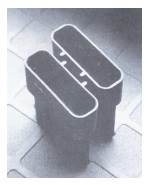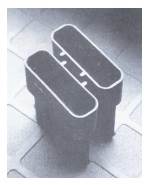Cryogenic Treatment Enhances Stability For Wire EDM Operation
In the world of Wire EDM professionals, the mission is very similar to NASA's, in minimizing scrap rate and in maximizing quality (i.e. meeting customer specifications). That is the challenge to each Wire EDM operator and tool designer.
Before a NASA space shuttle crew takes off into outer space, a series of "goes" contained in a check list must be configured to minimize catastrophic failures, and to maximize the success of the mission and its safe return. In the world of Wire EDM professionals, the mission is very similar to NASA's, in minimizing scrap rate and in maximizing quality (i.e. meeting customer specifications). That is the challenge to each Wire EDM operator and tool designer. Before the Wire EDM operator gives it a "go" (starts his machine cycle), there is a responsible and lengthy check list of concerns, which if not checked off could result in scrapping the work at hand. Some of these concerns are:
- workpiece perpendicularity
- workpiece home coordinate reference
- workpiece type (material conductivity factor)
- workpiece cross section
- wire size
- wire guide height
- wire feed rate
- wire tension
- P-M of wire guides
- P-M of wire power take-offs
- Dielectric value of the de-ionized water
- Water flushing controls
- Water flushing positioning
- Temperature of the water
- Temperature of the surrounding environment (room temperature)
- Machine coordinate resolution (X, Y, U, V, Z axis)
- Machine power settings
- Machine surface feed rate.
High Preparation, High Cost
The cost per hour normally associated with Wire EDM work ranges from $50 to $100 per hour. Maintaining the check list requires added operator time and preventive maintenance time. In addition to these added cost factors, the tool cost (the cost of the brass wire that is used during burning) is higher per piece machined when compared to any other machining process such as turning, milling, lapping, honing, polishing, and grinding. These high costs associated with Wire EDMing command highly trained, experienced Wire EDM operators, to ensure machining success. Their ability to program a proper sequence for the wire path is very dependent upon this check list. Once the check list checks out, it's a "go", and the programmed path of the wire is O.K., and if dimensional stability is not met on part size, then one is likely experiencing the phenomenon of work-piece instability. Dimensional stability is one of the most challenging problems for the Wire EDM operator. This occurrence happens quite often when Wire EDMing hardened steels and trying to deal with tolerances specified by customers who require tolerances of ±.0001" (within tenths).
Wire EDM Machine Manufacturers' Efforts
A great deal of design effort has been spent by Wire EDM machine manufacturers in efforts to counter or minimize the instability effects of workpiece movements. Stabilization features are very much a part of the equipment offered by wire EDM manufacturers today. These features attempt to regulate and compensate wire burning action. The results appear to smooth out (stabilize) the values during burning. The Wire EDM operator must be aware that machine stabilization features cannot fully overcome workpiece instability.
Explaining The Workpiece Instability Effect
To demonstrate the phenomenon of workpiece movement during Wire EDM, it's helpful to use the analogy of comparing a tin cup containing pencils to a hardened steel workpiece. The outside shape of a workpiece (the skin) is much like a tin cup, while what is inside of the workpiece (the microstructure) is much like the content of pencils in the tin cup. Unstable hardened steel comes with an inherent compressed microstructure similar to a tin cup that has one too many pencils jammed inside. The tin cup or the external skin of the workpiece is highly stressed just like the tin cup the steel parts surface (skin) does not want to yield to these stresses and is not elastic. What happens during Wire EDM burning is that you are removing stock from the outside of the skin surface of the steel workpiece. In doing so, you are allowing the workpiece to move (or warp). The stresses internally are trying to reposition, to try to find equilibrium, and like the tin cup, this weakening or shaving of its wall thickness can distort the cup's shape when pencils are jammed tightly inside.
This problem is not just an experience that occurs during Wire EDM burning (causing spark out problems), but one which can also show up during RAM EDMing (causing excessive back-up during finish burning), and again during grinding (causing bowing).
Achieving Workpiece Stability
To ensure that hardened steel will not move during Wire EDMing, a heat treatment solution is called for. And more specifically, a heat treatment that uses a deep cryogenic step (-320°F) as an "extended quench" between the post- austenitizing quench and the first temper. This deep freezing of steel at this stage of heat treatment will result in a steel's most stable microstructure following tempering.
Explaining The Workpiece Stability Effect
To demonstrate the stable workpiece action, it is useful once again to employ the analogy of the tin cup containing pencils to a hardened steel workpiece. But, this time, the hardened steel workpiece was heat treated with the "extended quench" i.e. the deep cryogenic treatment at -320°F, which produces a stable microstructure. This stable microstructure is accompanied by low internal stresses much like a tin cup that had one too many pencils in it, until you pulled one out, relieving the stress. The pencils then are loosely held within the cup. During Wire EDM burning, when stock is removed on the outside skin of the steel workpiece, the inside pressure forces do not push outward, thus warping the part's surface, much as the tin cup's wall weakens - it does not distort its shape, because the pencils are loose, without pushing outward on the inside wall surface.
Case Study Demonstrating Dimensional Stability
A.J. Goddard, President of Goddard Enterprises, a machine shop in Boulder, CO, reports: "In the Wire EDM process you are sometimes required to make small intricate parts that would otherwise be nearly impossible to make. Some of these parts have tolerances of + or - .0002", and a finish of 16 rms. One of the parts we make is a 440sst Rc58-60 load comb for the computer disc drive industry, with a surface profile of + or .0002", and finish of 16 or better in some areas (see photo). During the roughing burn, parts would tend to warp up .001" either direction, and subsequent finishing passes would not clean up the parts to tolerance. To obtain these tolerances and finishes, we found the need to first rough the part and then go back and do several finishing passes. These passes are usually only a few tenths of a thousand (.0002"). If the part has moved more than a few tenths, it usually means the part has to be scrapped. In the past, to stabilize the material, we would do a triple draw during heat treating. This helped the warpage problem, but the hardness dropped below the desired results. Another way we tried to compensate for the part moving, was to add several roughing cuts. This worked, but if you have ever been around a Wire EDM, you know it is not a fast process, and this would increase the run time 30%. There was also more time required to program the added cuts. After trying cryogenic treatment, the hardness was good, and we could go a single rough-cut with 3 finish cuts. This really simplifies the whole process, and the scrap rate was reduced to near nothing."
Adding To The Wire EDM Checklist
As a Wire EDM operator, before you start your machine cycle you should ask the question: "Has my hardened workpiece been cryogenically treated during heat treatment?" It should be, to minimize the risk of scrapping the work at hand. So, you should add to your Wire EDM checklist the requirement that all hardened workpieces be cryogenically treated as a standard practice for Wire EDM application. If your heat treater doesn't have the proper equipment to perform an "extended quench", (deep-cryogenics) during the heat treat process, you should find one that does.
About The Author: Dennis Kamody has more than ten years experience as a maintenance supervisor in the tool and die industry, understands Wire EDM equipment and techniques, and holds twc U.S. Process Patents on deep cryogenic treatment (U.S. Patent No. 5,875,636 and U.S. Patent No. 5,259,200).
He is the founder and President of Nu-Bit, Inc., a Pennsylvania firm begun in 1991 in New Kensington, PA, Pittsburgh suburb. Nu-Bit designs and manufactures the Cryomersion© machine line of liquid nitrogen immersion units. The Cryomersion© machine using the NBP© cryogenic process is the ideal "extended quench" for the heat treater. The NBP liquid cryogenic process differs significantly from conventional controlled-dry-atmosphere cold box technology, and the NBP© Process was developed to solve the long-cycle-time problem inherent in cold boxes, with the result that the solution enables a deep cryogenic step to be easily incorporated as an "extended quench".
EDM Today would like to thank Dennis Kamody for contributing this article as part of a deep-cryogenic awareness campaign for the metals industry.
This article brought to you with the permission of EDM Publications, Inc., publisher of EDM Today, with offices at 230 West Parkway, Unit 3-1, Pompton Plains, New Jersey 07444. Copyright © 2000 by EDM Publications, Inc. Our thanks to the staff of EDM Today for their assistance.
Related Content
Choosing The Right Grinding Wheel
Understanding grinding wheel fundamentals will help you choose the right wheel for the job.
Read MoreChoosing Your Carbide Grade: A Guide
Without an international standard for designating carbide grades or application ranges, users must rely on relative judgments and background knowledge for success.
Read MoreWatchmaking: A Machinist’s View
Old-world craftsmanship combines with precision machining on a vertical machining center and Swiss-type lathe to produce some of the only U.S.-made mechanical wristwatch movements.
Read MoreInside an Amish-Owned Family Machine Shop
Modern Machine Shop took an exclusive behind-the-scenes tour of an Amish-owned machine shop, where advanced machining technologies work alongside old-world traditions.
Read MoreRead Next
EDMing Beryllium Copper: An Introduction
Beryllium copper offers many benefts to the moldmaker and plastic injection molder, yet questions remain on how to best EDM it, which alloy to specify, where to use it, and is it safe to work with?
Read MoreThe Cut Scene: The Finer Details of Large-Format Machining
Small details and features can have an outsized impact on large parts, such as Barbco’s collapsible utility drill head.
Read More







.jpg;maxWidth=300;quality=90)





.png;maxWidth=300;quality=90)















.jpg;maxWidth=970;quality=90)